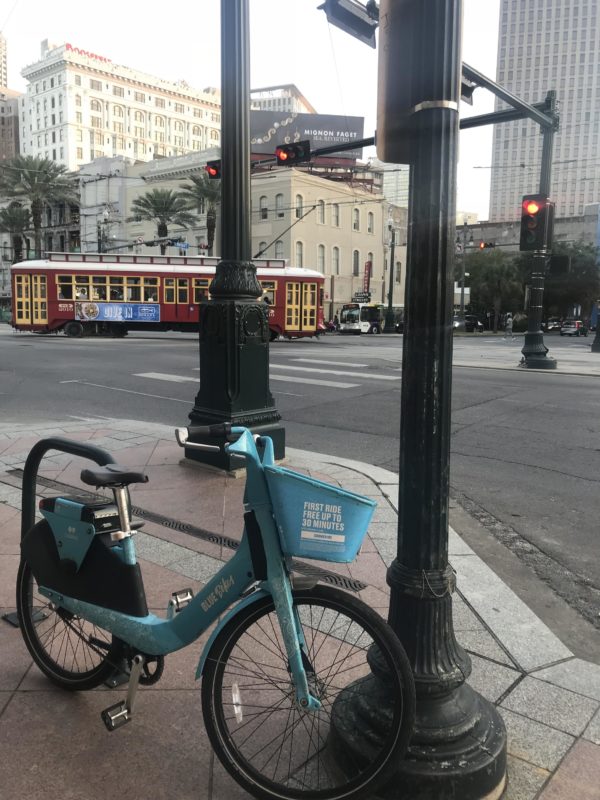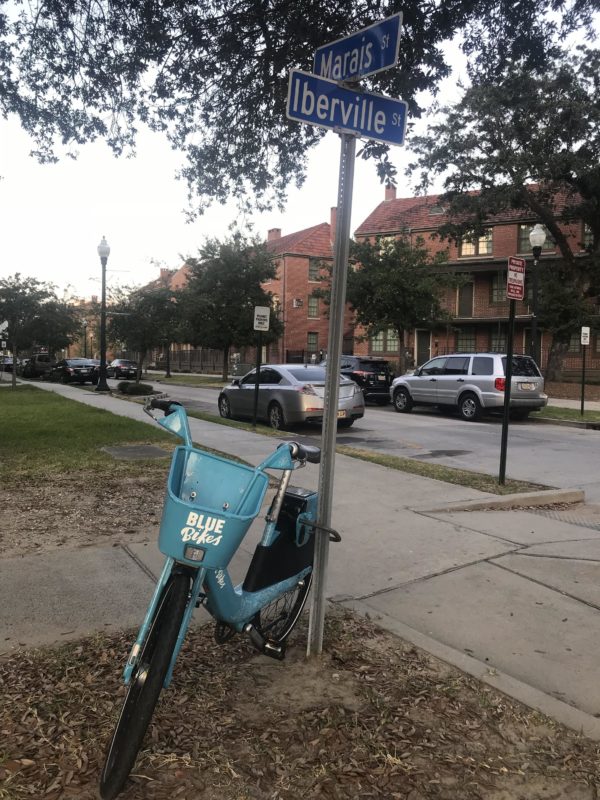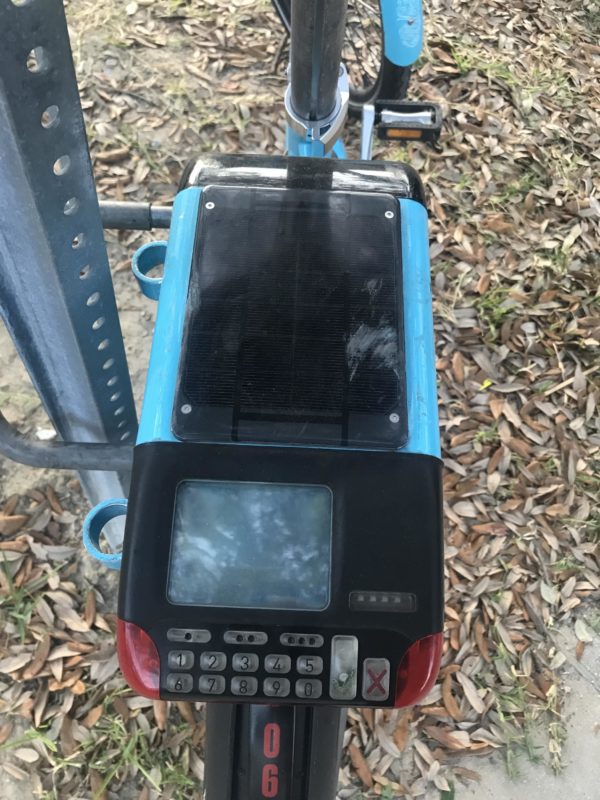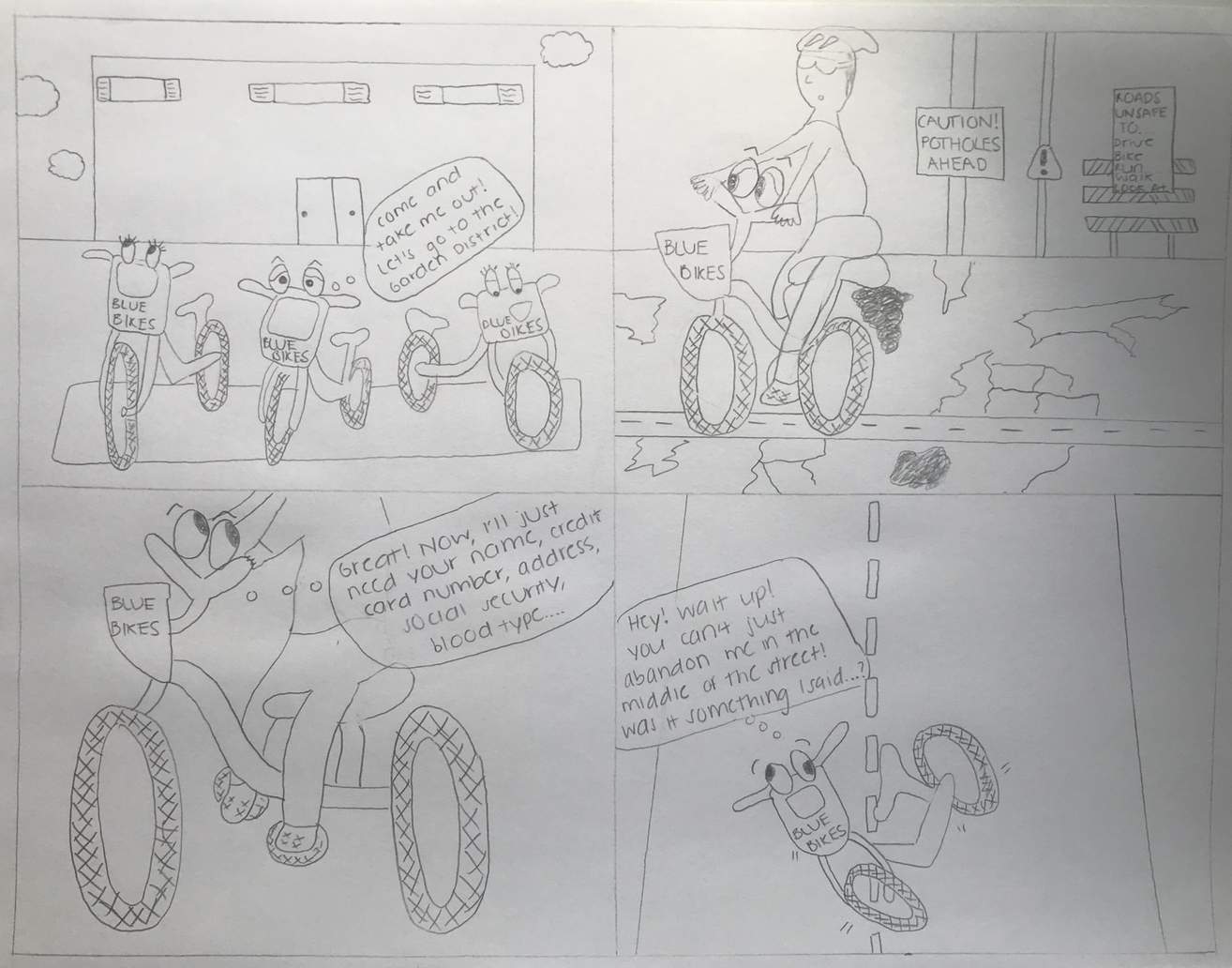Editor’s Note: The following series “Car-free Commute” is a week-long series curated by Erica Casareno as part of the Digital Research Internship Program in partnership with ViaNolaVie. The DRI Program is a Newcomb Insitute technology initiative for undergraduate students combining technology skillsets, feminist leadership, and the digital humanities.
Car-free transportation in the Big Easy is hardly ever care-free. For the New Orleanian without a car,figuring out the best mode of transit from home to to the grocery can feel as challenging as choosing what recipe to make. Amid time-shortages, potholes, frequent showers, and Louisiana heat, choosing the best form of car-less transit can be tricky. This grouping of articles explores and appreciates the different forms of transit in New Orleans, no driver’s license or car necessary. One transportation installation, the “Blue Bikes” of New Orleans, as Alexa Kravitz explains in this January 22, 2020 article originally published on NolaVie, is nothing short of public art.
While New Orleans is more often recognized for its beads and beignets rather than biking, this changed with the 700 new ride share bicycles installed throughout the city in December of 2017. Upon approaching the 70 unattended “Blue Bike” stands making themselves at home across New Orleans, one’s thought wouldn’t initially be to consider the shiny new bikes as a form of public art, but that is precisely what they are.
Robotically assembled in a clean line, the bicycles sit awaiting riders to enter their PINS into electronic keypads on the back of each bike. Bikes cost $.10 per minute after a $5 signup fee, and upon completing a ride, riders can leave and lock the bikes wherever they wish across New Orleans for a small fee. This permission to haphazardly abandon the bikes has left behind a flood of bikes chained to street signs, arbitrary bicycle racks, or strewn across the grass of City Park, with nothing left behind but the GPS tracking as a memory of the ride once taken.

Photo of Blue Bike (Photo: Alexa Kravitz)
Public art has been defined as something that can “enhance our environment, transform a landscape, heighten our awareness, or question our assumptions. Placed in public sites, the art is there for everyone, a form of collective community expression”(10). The Blue Bikes and their artful, random placement seem to perfectly fit the bill. However, the bikes’ classification as art is deeply tied to their function, thus classifying the bicycles as a variation of performance art — starting with the very moment riders register for the system. Individuals must pay to use the bikes, interact with touch screens to unlock them, insert the U-lock into the holster and even press handlebar buttons to stop. All the while, passerby gawk as new riders struggle to navigate the system or as old riders carelessly lock the bikes where they please. The rest of us are left to carefully maneuver ourselves around bikes strewn on sidewalks and locked onto street signs.
The bike classification as performance art becomes even more interesting upon investigating why the program was even initiated in New Orleans, a city so obviously unfit for bicycle-based transportation. According to the National Highway Traffic Safety Administration, “New Orleans had nearly 4 cyclist deaths per 100,000 people from 2007 to 2016”(3). Moreover, New Orleans’s infamously crumbling streets also are not necessarily fit for a new form of street transportation. In their article, “How bad are New Orleans’ streets?” Nola.com stated that, “The average condition of all roads in the city rates less than 43 on a scale of 100, and nearly two-thirds of the streets are in ‘poor’ or worse condition”(1). In a citywide Pavement Condition Assessment, more than 65 percent of city roads were given grades of D or worse. The pavement report stated that, “it would take $5B in funding to repave all of the City’s streets that are currently in poor or worse condition”(4). This is concerning due to Blue Bikes’ decision not to incorporate sturdy, puncture-proof tires in the bike structure. Since bikes are- by their very nature- prone to get flat tires, this seems to be an even more irresponsible and thoughtless decision in light of the weak bicycle infrastructure in New Orleans.
There is also the influence of crime to consider with the Blue Bikes. In 2018, a bike- share system in France where bikes could be “locked anywhere” terminated less than six months after launching when, “more than a thousand bikes had been stolen and almost 3,400 damaged nationwide, with 6,500 repairs needed”(5). In China, the Wukong Bike bike-sharing program was forced to cease operations “after 90 percent of its bicycles went missing, just five months after it started operations”(9). With this ever-reliable history of crime surrounding bike-sharing, how is it possible that this system will survive in a city with such an undeniably high crime rate?

Photo of Blue Bike (Photo: Alexa Kravitz)
But perhaps the most critical aspect of the Blue Bike program is how it affects our privacy. Our lives on the Internet have become a medium through which intrusion has become mainstream. We are living in an era where technology has evolved to follow our every move, and the Blue Bike bike-sharing is no exception. Though the bikes are cloaked in a comforting shade of blue — a color known to symbolize trustworthiness and reliability — each bike comes equipped with a GPS tracking system. Known as “smart bikes,”(2) the vehicles can generate elaborate digital rider profiles detailing rider behavior and itineraries instantly. For example, imagine that you’re traveling to a location you would prefer be kept secret — a sexual health clinic, a therapist office, a bar extremely late in the evening — however, with the GPS system installed onto the Blue Bikes, all of this information has the potential to become public knowledge. Our private travel information suddenly is at the disposal of a tracking device that can do as it wishes with the data. Instantaneously, our concealed human attributes that we would prefer be kept confidential are exposed and our highly coveted privacy is stripped away.
In UC Berkeley’s Technology Law Journal,the author articulates how GPS technology affects the ideals behind surveillance protections. The author recalls “The D.C. Circuit [Court of Appeals] found that the method of continuous monitoring was as intrusive as other activities the Supreme Court found to be a search under the Fourth Amendment. The court noted that society reasonably expects citizens to be free from the prolonged twenty-four-hour surveillance enabled by GPS tracking,” (“Locating Location Privacy, 49”) (6). The issue of cybersecurity by result of imposing GPS tracking has grown so prevalent that it required addressing by a state supreme court.
Data surveillance has become standard for corporate Internet giants that wish to maximize profit around consumer habits. For example, Lina Khan’s The Separation of Platforms and Commerce states that “[Amazon] enjoys exclusive access to voice data that Alexa collects. Alexa maintains access to this data even when the information is collected through third-party skills, and Amazon can use the information to… enrich parts of its business,” (Khan 997) (8). The Blue Bike system as it relates to a potential breach in our cybersecurity serves as a small microcosm of the issue we are experiencing in our world. Just as we must “perform” around the Blue Bikes as we attempt to register for, ride or even avoid them, we are also constantly being monitored by higher level entities encroaching on our information. Our daily interactions with large corporations have proven to be something of its own performance art, and citizens must “perform” with powerful conglomerates that recycle our exploited data back to us. This also begins with the Blue Bikes the moment that we approach their keypads fixed to the backs. Just as individuals must enter a PIN number to unlock phones that store their data, cyclists must do the same for bikes. Also, the keypad seemingly resembles a credit card reader with its boxy shape and clear lettering- ironically confirming its identity as a data-consuming device.

Photo of Blue Bike (Photo: Alexa Kravitz)
Blue Bikes were introduced in New Orleans as a seemingly innocent transportation system. The sporadic bursts of blue through the city serve as forms of public performance art for all to interact with. In GoNola.com’s, “Where to Find NOLA Street Art,” it’s stated that “Public art is to a city what a soul is to a body. You could survive without it, but the spirit it provides would vanish”(7). With their sleek structure, inexpensive price, simple registration and flexible drop-off locations, the bike- share system seems all but perfect in theory. Nonetheless, one cannot blindly accept the bikes’ appeal without questioning their true practical value here. Those who choose to interact with the bikes must also accept that they are voluntarily giving away personal information and fueling the data collection that has become acceptable in our society. Thus, though the bicycles may provide an easy alternative mode of transportation, the implications at the root of this program may reach far beyond the distances they were intended to travel.

Cartoon on Blue Bikes (Drawing by: Alexa Kravitz)
Sources:
1: Adelson, Jeff. “How Bad Are New Orleans’ Streets? Fixes Require Billions, Study Shows, with Two-Thirds ‘Poor’ or Worse.” NOLA.com, 28 Aug. 2016, www.nola.com/news/article_23d5858e-b9ff-52f7-a1dd-07c7bb93aec3.html. Accessed 20 Sept. 2019
2: “Bike Share – FAQ – City of New Orleans.” Bike Share – FAQ – City of New Orleans, www.nola.gov/bike-share/faq/#where. Accessed 20 Sept. 2019
3. Brown, Jasmine. “New Orleans Named One of the Most Dangerous Places to Bicycle in America.” New Orleans Named One of the Most Dangerous Places to Bicycle in America | Where Y’at, 26 Sept. 2018. www.whereyat.com/new-orleans-named-one-of-the-most-dangerous-places-to-bicycle-in-america. Accessed 1 Oct. 2019.
4: City of New Orleans. City-Wide Pavement Condition Assessment Results . 30 Aug. 2016, wvue.images.worldnow.com/library/a6429dd1-4b4b-49ab-9ef9-5323ea1749b8.PDF. Accessed 20 Sept. 2019.
5. France-Presse, Agence. “Gobee.bike Pulls out of France Due to ‘Mass Destruction’ of Its Dockless Bike Fleet.” The Guardian, Guardian News and Media, 25 Feb. 2018, www.theguardian.com/world/2018/feb/25/gobeebike-france-mass-destruction-dockless-bikes. Accessed 1 Oct. 2019.
6: Goetz, David H. “Locating Location Privacy .” Berkeley Technology Law Journal , Vol. 26, 2011, pp. 823–858. Accessed 20 Sept. 2019.
7: Hernandez, Emily Ramirez. “Where to Find NOLA Street Art.” GoNOLA.com, GoNola, 7 Dec. 2018, gonola.com/things-to-do-in-new-orleans/where-to-find-nola-street-art. Accessed 20 Sept. 2019.
8: Khan, Lina M. The Separation of Platforms and Commerce . Columbia Law Review, May 2019. Accessed 20 Sept. 2019.
9. Lam, Lydia. “China’s Bike-Sharing Firm Wukong Bike Closes after 90% of Its Bicycles Go Missing.” The Straits Times, 20 June 2017, www.straitstimes.com/asia/east-asia/chinas-bike-sharing-firm-wukong-bike-closes-after-90-of-its-bicycles-go-missing. Accessed 1 Oct. 2019.
10: “What Is Public Art?” Association for Public Art, www.associationforpublicart.org/what-is-public-art/. Accessed 20 Sept. 2019.
 NOLAbeings
Multimedia artist Claire Bangser created NOLAbeings as a portrait-based story project that marries...
NOLAbeings
Multimedia artist Claire Bangser created NOLAbeings as a portrait-based story project that marries...
 Data corner: Adobe Suite (create a PDF, social media graphic, presentation, edit a photo and video
Data corner is where you go to work with analytics and top tech skills. It takes on everything from PERL and SQL to Canva and Sprout Social.
Data corner: Adobe Suite (create a PDF, social media graphic, presentation, edit a photo and video
Data corner is where you go to work with analytics and top tech skills. It takes on everything from PERL and SQL to Canva and Sprout Social.
